A Settlement Called Midriver
(unincorporated county)
Eloise Bailey Thompson
(Reprinted here with the permission of the author.)
#15
8/31/90
BACKGROUND
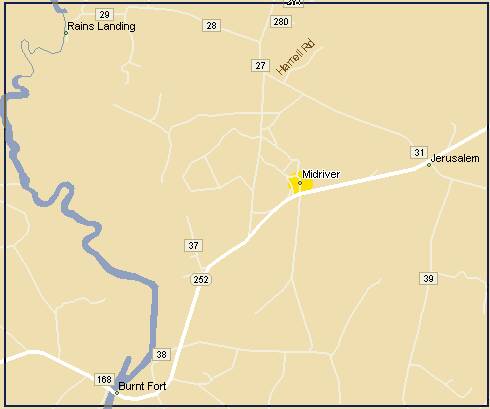 Midriver
sits on a sandy ridge near State Road 252. Midriver is east of Burnt Fort
and west of Jerusalem -near the "Old" Post Road. If this confuses you, look
at your county map for all three places are shown. Its name is a natural for
it is the midway point between Owen's Ferry and Raines's Landing (3R Fish
Camp) on the Satilla, among the "Sand Hills" of Camden County. The
topographical map shows ridges 60 feet above sea level there. Midriver
sits on a sandy ridge near State Road 252. Midriver is east of Burnt Fort
and west of Jerusalem -near the "Old" Post Road. If this confuses you, look
at your county map for all three places are shown. Its name is a natural for
it is the midway point between Owen's Ferry and Raines's Landing (3R Fish
Camp) on the Satilla, among the "Sand Hills" of Camden County. The
topographical map shows ridges 60 feet above sea level there.
Even though a dot marks Midriver, it has no city signs, nor city limits. You will see no town hall nor church nor school nor any distinguishing
feature. You will have to ask. At the time Midriver was an active community,
no paved road came nearer than U.S. 17 - and that not until 1912. The White
Oak-Burnt Fort Road was not paved until 1956.
THE TRAVELS OF WILLIAM BARTRAM, Ed. by Mark Van Doren p. 42
The first recorded information about this section came in the 1700s when
naturalist William Bartram passed right through these sand hills to cross
the Satilla River at Brown's Ferry (later Owen's Ferry). He described his
journey leading from the Altamaha to the Satilla. "I mounted my horse and
followed the high road to the ferry on the St. Ille, about sixty miles south
of the Altamaha, passing through an uninhabited wilderness. The sudden
transition from rich cultivated settlements, to high pine forests (sic),
dark and grassy savannas, forms in my opinion no disagreeable contrasts; and
the new objects of observation in the works of nature soon reconcile the
surprised imagination to the change. The great land-tortoise, called here
Gopher, present a very singular appearance; these vast caves are their
castles and diurnal retreats, from whence they issue forth in the night, in searach (sic) of prey. The little mounds, or hillocks of fresh earth, thrown
up in great numbers in the night, have also a curious appearance.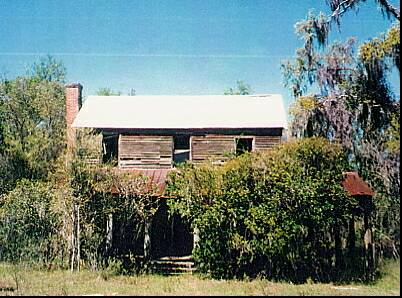
(Photo to right courtesy of Marguerite M. Mathews © 1985, 1995, 1996,
2012.)
"In the evening I arrived at a cow-pen, where there was a habitation, and
the people received me very civilly. I staid here all night, and had for
supper plenty of milk, butter, and very good cheese of their own make, which
is a novelty in the maritime parts of Carolina and Georgia; the inhabitants
being chiefly supplied with it from European and the northern states. The
next day's progress, in general, presented scenes similar to the preceding,
though the land is lower, more level and humid, and the produce more varied;
high open forests of stately pines, flowery plains, and extensive green
savannas, checquered with incarnate Chironia pulcherrima, and Asclepias
fragrans, perfumed the air whilst they pleased the eye. I met with some
troublesome cane swamps, saw herds of horned cattled (sic), horses and deer,
and took notice of a procumbent species of Hibiscus,... I also saw a
beautiful species of Lupin, ... celestial blue. ..some milk white... on dry
sandy heights, in open pine forests, which are naturally thin in
undergrowth... The vegetative mould is composed of fine white sand, mixed
and coloured, with dissolved and calcined vegetable substances, but this
stratum is not very deep and covers one of a tenacious cinereous coloured
clay, as we may observe by the earth adhering to the roots of trees, torn up
by storms, etc, and by the little chimnies, or air holes of crayfish, which
perforate the savannahs. Turkeys, quails and small birds are here to be
seen; but birds are not numerous in desert forests; they draw near to the
habitations of men, as I have constantly observed in all my travels.
"I arrived at St. Ille's in the evening, where I
lodged, and next morning, having crossed over in a ferry boat, sat forward
for St. Mary 's . ..."
EARLY HISTORY
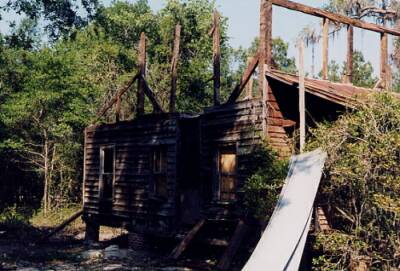
(Photo to left by Tara D. Fields (© 1999-2012.)
Early history of Midriver is sketchy, but closely allied with that of
nearby Burnt Fort. It may well be that the families of those early timbermen
who populated Burnt Fort, spilled over into the area later became known as
Midriver. According to CAMDEN'S CHALLENGE, the earliest information about
Burnt Fort began with Gray's Gang settling in land disputed by British and
Spanish governments. Edmond Gray led his followers there and established New
Hanover in 1755. After the Spanish Government protested a settlement in
so-called neutral territory, he moved to Cumberland Island.
Twenty years later, a fort was either built or rebuilt on or near the
Gray site to protect settlers then moving into the area, mainly as cattlemen
from Indians still claiming this territory and Spanish moving up from East
Florida. The site of the fort on the west side of the Satilla appears on
maps of this period. It later burned, hence Burnt Fort.
More settlers appeared as the threat of Indian attack lessened with the
ceding of what was then the western portion of Camden County to the U. S.
Government in 1802.
1800's
The vast yellow pine forests had already been recognized as a great
resource with timber cutting and naval stores operation profitable
throughout the lower coastal region as early as the Colonial Period. Now New
England shipbuilders and timber men began moving in to utilize these
woodlands.
Alex McQueen's HISTORY OF CHARLTON COUNTY tells that a sawmill was
established at Burnt Fort in 1839 by a group from Maine. This was the first
steam mill to be operated in the area. "This mill operated for a period of
several years, and the families that came out with this colony quickly
identified themselves with the country and the people then living in this
section". McQueen names the families that moved in then and remarked that
many had descendants in the area: Marrs, Libbys, Kennisons,
Lloyds, Purses.
Another group would come in later in the fifties to establish other
mills: John, Jim, and Frank Bailey, Watson,
Merrow. Workers from these mills
and their families spilled over into the entire region, increasing the
population of the area now recognized as Midriver.
Planting was also an important enterprise in these antebellum days. The
1860 Camden County census shows in the Owen's Ferry District, which included
Midriver territory, twenty-nine white families living there (black families
were not shown in population records until 1970). Males over 15 numbered 49
and 32 of those were farmers. Two female farmers were shown.
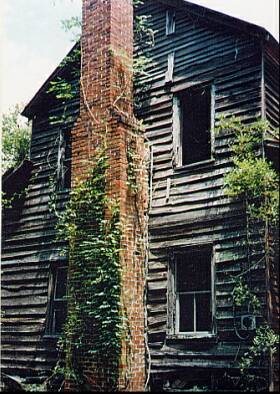 Familiar
names associated with this section are found in the census records (shown as
Owen's Ferry, but includes Burnt Fort, Bailey's Mill and Midriver, plus
outlying areas): Littlefield, Harrell, Readdick,
Parish, Merrow, Patterson,
Brown, Gelzer, Bates, Copeland, Southwell,
Godley, Hazelhurst, York, Somerall, Ennis,
Beasley, Ryals, Hopkins, Patterson, Holder,
Finley, Gelzer,
Watson, Bailey, Wolf, Robins, Palmer, Harvey,
Keeper, Guyton, Guerrard,
Owens, Tucker, Thomas. Familiar
names associated with this section are found in the census records (shown as
Owen's Ferry, but includes Burnt Fort, Bailey's Mill and Midriver, plus
outlying areas): Littlefield, Harrell, Readdick,
Parish, Merrow, Patterson,
Brown, Gelzer, Bates, Copeland, Southwell,
Godley, Hazelhurst, York, Somerall, Ennis,
Beasley, Ryals, Hopkins, Patterson, Holder,
Finley, Gelzer,
Watson, Bailey, Wolf, Robins, Palmer, Harvey,
Keeper, Guyton, Guerrard,
Owens, Tucker, Thomas.
One of the few antebellum houses still standing in Camden County is the
two story house about 1/4 mile off paved road at Midriver. This was built in
the 1840's by Jacob Tapley Goodbread; he was sheriff from 1839-1842. It is
said he resigned because he refused to hang a man he was convinced was
innocent. Mr. Goodbread moved from the county in the early
1840's to Columbia
County, Florida. He had married Jane Dean Brown in 1832.
After Sheriff Goodbread left, a retired doctor from Savannah lived in the
house and was killed in some dispute with a slave. The house is said to be
haunted. Annie Belle Buie recounted that the Jim
Buie family (her husband was
Duncan) lived in there for a time when children were small (after 1912) and
Mrs. Jim Buie always insisted ghosts were there.
A 1917 map shows that this house was located near a crossroads leading
from Jerusalem and Owen's Ferry to Burnt Fort and one that joined the Old
Post Road.
It is now in poor condition. The brick chimney still stands. Unpainted
weatherboarding is lichen covered and falling off in some places. The sturdy
square heart timbers used for supports can be seen. Several deteriorated
outbuildings still stand. Catalpa trees, ligustrum, crepe myrtle are near
the house. Maddie Brown sold the house to J.A. Moore, who owned it and
approximately 1700 acres.
Note: in 1999 the owners began to tear the house down. Apparently they
are selling off parts of the house - such as the valuable bricks. - Tara. (Photo courtesy of
Marguerite M. Mathews © 1985, 1995, 1996.)
The first documentation for the Midriver name came in November 1898 when
George Gowen was appointed Midriver's first postmaster. According to his son
Barney Gowen of Woodbine, George was then working for turpentine still owner
L.T. McKinnon as bookkeeper and clerk in his commissary near his Midriver
still.
He was followed Carl M. McKinnon in 1899 and Lee McGoogan in 1902.
Clyde McCarthy was appointed postmaster in 1908 while employed by
Mr. McKinnon in
the commissary. He and McKinnon soon became partners in a widespread naval
stores operation according to his son Lawrence McCarthy. When
Mr. McKinnon
moved his operations out of the county, Mr. McCarthy continued in the naval
stores and timber business until his retirement.
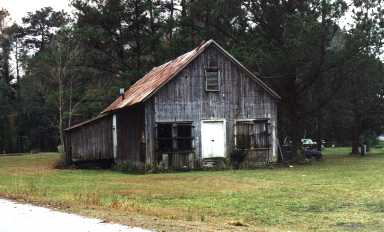
(Photo to left by Tara D. Fields (© 1999-2012.)
Walter C. Hopkins, another timber man as named postmaster in 1910.
J.
Brown Godley was next in 1911. Allie Readdick Brown was the last postmaster
at Midriver, appointed in 1914. Postal service moved to White Oak May 31,
1917.
Allie Brown Carmichael described her life in the Midriver area in PEN
PORTRAITS, a collection of reminiscences compiled by the Woodbine Woman's
Club in 1969. Her grandparents were James David and Pope
Godley Brown and Dr. Thomas L. and Anne Reid
Gelzer. All lived nearby.
Her parents Hugh and Alice Gelzer Brown married in 1884.
Mr. Brown was an
overseer at Owen's Ferry rice plantation.
Allie Brown married Jim Carmichael, who carried the mail from White Oak
to Midriver and Hazlehurst Plantation. They later moved to south Camden, then
Miami.
She told that during her childhood the nearest store and post office to
them was at Owen's Ferry, four miles away. Here they worshipped in the
Episcopal Church or at the one at Burnt Fort. She went to school at Burnt
Fort.
The nearby countryside was "beautiful" with "great oaks covered with
Spanish moss", "stately cypress" and "huge pines marred by being boxed to
hold rosin".
The store or commissary at Midriver was possibly built by
L.T. McKinnon.
(Note writings of Allie Carmichael's stated they shopped at Owen's Ferry.)
Brown Godley bought the store and ran it around 1911. According to this son
Edwin Godley, "It was a typical country store like those at Tarboro or Burnt
Fort".
"Midriver was a community where people lived all around in the woods
before timber companies began buying up small tracts and consolidating them." People from Jerusalem and Rough and Ready and all around came in on
Fridays and Saturdays to buy their week's groceries".
Margaret Godley Reddick, niece of Brown
Godley, remembered the old store
and believed that B. built the new larger one. Jack Godley, her younger
brother, remembered when the older store to the right of house as you faced
road was tumbling down. The newer store was to the left of the house. It was
still operating in the 1920's but was eventually torn down.
The father of Marguerite and Jack, Andrew
Godley, was tax collector. By
the time Cato Brown was operating store, Jack was old enough to go with him,
where his father would set up tax books in the store. Property owners would
have been notified through notices in the county paper, and would come in
when tax collector was "making his rounds." Jack recalled that they always
ate dinner with "Uncle Cato" and that he always "gave us kids candy."
They lived in old Goodbread House. Mr. Godley sold to
Cato Brown. Maddie Brown Clark's writings in PEN PORTRAITS show that she was the daughter of
Cato Brown. Mr. Brown married Allie Readdick in 1894 and moved into the
Goodbread house. He operated a store there, farmed and raised cattle. Her
grandparents lived in the area; William and Hattie Holland
Brown and John
and Amanda Gowen Readdick.
Old buildings still related to Midriver settlement are Goodbread House
and a short distance to west is David and Annie Fouraker
Littlefield's house. Their son Carnie and his wife Kitty
Godley were the last to live there. It was built around 1917,
or thereabouts.
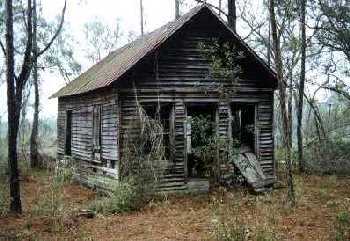 The
Midriver/Burnt Fort one-room school still stands. This was built in the
1890s on a sandy ridge between Gelzer Branch and Schoolhouse Branch in the
Midriver community, according to an article written by Marguerite Reddick in
1973. The
Midriver/Burnt Fort one-room school still stands. This was built in the
1890s on a sandy ridge between Gelzer Branch and Schoolhouse Branch in the
Midriver community, according to an article written by Marguerite Reddick in
1973.
Burnt Fort and Midriver schools were consolidated in 1918 and this was
the larger, so it was moved three miles which placed it near the Burnt Fort
Church. J.A. Wells was in charge. Nine yoke of oxen were used to pull the
building through the sandy roads. Others involved in the move were J.F.
Russell, A.B. Godley, T.G. Godley, P.C. Brown, M.A. Godley,
Y. Haywood, L.F. Godley, J.O. Dyal, M.P. Phillips.
It took three days to move it. It was in use until 1921 when all schools
were consolidated and white students were bused to White Oak. (Black
students went to Tarboro, Rough & Ready, Oak Hill.) The little wooden
building still stands near the rebuilt Burnt Fort Church. Allie
Brown Carmichael recalled the double desks with two children at each desk,
spelling bees and copy books. The big globe in the classroom made a
particular impression on her.
SOURCES: BARTRAM'S TRAVELS; CAMDEN'S CHALLENGE; HISTORY OF CHARLTON
COUNTY, McQueen; 1860 Census: P.O. Records; PEN PORTRAITS; County maps,
current and 1917; Article, Southeast Georgian, M. Reddick, 1973; Interviews:
Lawrence McCarthy, Marguerite Reddick, Shirley
Thompson, Anna Belle Buie,
Jack Godley, Edwin Godley, Barney Gowen. Personal Observations. |